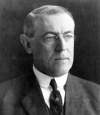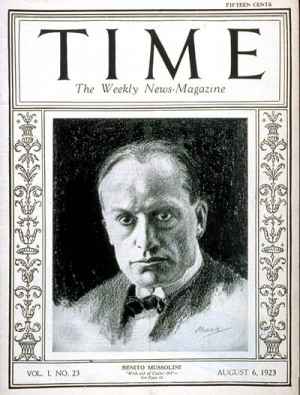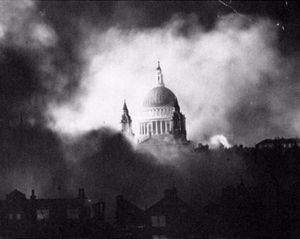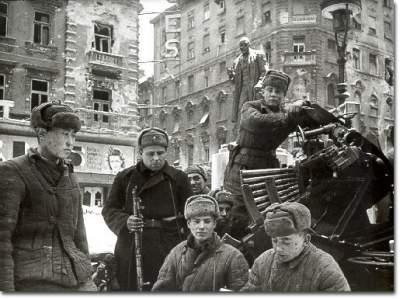
December 28
1856: Birth: Woodrow Wilson: Thomas Woodrow Wilson, who will become the 28th president of the United States, is born on this day in Staunton, Virginia.
A former president of Princeton University and governor of New Jersey, Wilson won election to his first term in the White House as a Democrat in 1912 on a campaign program called The New Freedom, which stressed individualism and states' rights. From the day he took office in March 1913—when a parade organized by the Congressional Union, later to become known as the National Organization for Women, drew crowds away from the inauguration ceremonies—Wilson had to contend with the growing controversy over women's suffrage on the home front. His administration saw the passage of several major acts of legislation, including the Federal Reserve Act and the creation of the Federal Trade Commission, designed to regulate business practices.
As war broke out in Europe in the summer of 1914, Wilson lost his wife of thirty years, Ellen, to liver cancer. Unable to abandon himself to his grief, he instead dedicated himself to his work, winning re-election in 1916 on a strict neutrality platform and the slogan He kept us out of the war. But Wilson soon decided that the U.S. could not remain neutral in the face of German aggression on the high seas and in April 1917 he asked Congress for a Declaration of War.
American participation in World War I helped turn the tide towards the Allies, and Wilson played a crucial role in determining the terms of the resulting peace. His famous Fourteen Points, presented to Congress in January 1918, introduced the idea of an international covenant aimed at resolving conflict, an idea that would come to fruition with the formation of the League of Nations. At Versailles in the months following Germany's surrender, Wilson struggled to convince his counterparts in Britain and France, David Lloyd George and Georges Clemenceau, that in order for peace to endure, Germany must not be punished too harshly.
Wilson faced even tougher resistance at home. In late 1919, the Versailles Treaty was defeated in Congress by steadfast opposition from Henry Cabot Lodge and other Republican legislators. (Because it was not ratified, the U.S. negotiated a separate Treaty of Berlin with Germany that was signed on August 25, 1921.) Despite this failure, Wilson was awarded the Nobel Peace Prize. His idea of his country as the world's leader in shaping international relations is a vision that, to a certain extent, has continued to inspire U.S. foreign policy to the present day.
Wilson left the White House in 1921 after suffering a physical breakdown and a stroke that left him paralyzed. Nursed by his second wife, Edith, he died on February 3, 1924. (History.com)
1914 World War I: Benito Mussolini: editor of the Milan Socialist party newspaper Avanti!, is at first opposed to Italy's involvement in the war but soon reverses his position and calls for Italy's entry on the side of the Allies. Expelled from the Socialist party for this stance, today he founds his own newspaper in Milan, Il Popolo d'Italia which will later become the party newspaper of the Fascist movement. Mussolini will serve in the Italian army until wounded in 1917.
1920 Volkishness: Theodor Czepl visits Karl Maria Wiligut (Weisthor) in Salzburg and stays for seven weeks. He is said to have visited with Wiligut on at least two other occasions during this period. Czepl records his visits in detail in a memorandum prepared for the Order of the New Templars (ONT). (THP) 1928 Weimar: Theodor Eicke: a security guard for I.G. Farben,joins the Nazi party and enlists in the SA.
1933 Volkishness: The Ahnenerbe: the Society for the Study of Ancestral Heritages, is privately founded by Frederick Hielscher, a mystic and friend of Swedish explorer Sven Hedin, who himself was closely associated with Karl Haushofer. (THP)
1934 Volkishness: The Edda Society: Hagal devotes three issues to the ancestral memory and mystical family traditions of Karl Maria Wiligut (Weisthor). (THP)
1935 Volkishness: Michael Prawdin (Michael Charol) publishes The Legacy of Genghis Khan, a sequel to his 1934 book on the same subject. Both are avidly read by Heinrich Himmler, who strongly recommends them to all those around him, including Hitler. (THP)
1936 Various: Church and Reich: Church and Reich: The German government gives the National Association of German Catholics Abroad a sum of more than 139,000 marks, in 1936 alone, for its pro-German and pro-Nazi activities among the German minorities of Poland, Romania, and Yugoslavia. (THP)
1937 Romania: King Carol appoints Octavian Goga and Alexander Cuza to head a National Christian Party government. During its 44 days in power it issues numerous anti-Jewish decrees. (THP)
1938 Holocaust: Jews are forbidden to use sleeping compartments or dining cars on German railways.
1940 World War II: Various: Blitz: 1941 USA: Request made for creation of construction battalions:
On this day, Rear Admiral Ben Moreell requests authority from the Bureau of Navigation to create a contingent of construction units able to build everything from airfields to roads under battlefield conditions. These units would be known as the "Seabees"—for the first letters of Construction Battalion.
The men chosen for the battalions were not ordinary inductees or volunteers—they all had construction-work backgrounds. The first batch of recruits who made the cut had helped build the Boulder Dam, national highways, and urban skyscrapers; had dug subway tunnels; and had worked in mines and quarries. Some had experience building ocean liners and aircraft carriers. Approximately 325,000 men, from 60 different trades, ages 18 to 60, would go on to serve with the Seabees by the end of the war. The officers given the authority to command these men were also an elite crew, derived from the Civil Engineer Corps. Of the more than 11,000 officers in the Corps all together, almost 8,000 would serve with the construction units.
Although the Seabees were technically supposed to be support units, they were also trained as infantrymen, and they often found themselves in combat with the enemy in the course of their construction projects. They were sent to war theaters as far flung as the Azores, North Africa, the Mediterranean, the Pacific, and the beaches of Normandy.
Some of the Seabees' feats became legendary. They constructed huge airfields and support facilities for the B29 Superfortress bombers on Guam, Saipan, and Tinian, as well as the ports needed to bring in the supplies for the bombing of Japan. The Seabees also suffered significant casualties in the process of providing innovative new pontoons to help the Allies land on the beaches of Sicily. During D-Day, the Seabees' demolition unit was among the first ashore. Their mission: to destroy the steel and concrete barriers the Germans had constructed as obstacles to invasion.
The Seabees' motto was "We Build, We Fight." (History.com)
1942 Various: Medical research: Stalingrad: Hitler sanctions a withdrawal by Army Groups Don and A to the line Konstantinovsk-Salsk-Armavir. This puts the army groups 125 miles away from Stalingrad and aggravates the resupply of Paulus still further. Even so, Hitler declares that he still intends to relieve the Sixth Army. Meanwhile the Russians can now prepare and execute the final reduction of the Stalingrad pocket. The final destruction of the German pocket at Stalingrad is to involve seven armies commanded by Rokossovsky's Don Front. Three of these were transferred from Yeremenko's Stalingrad Front, which on 1 January 1943 is renamed the South Front. This is to continue the attacks against von Manstein. (THP)
1943 World War II: Various: Italy: Atomic bomb: Robert Oppenheimer establishes the Los Alamos Laboratory.
1944 World War II: Various: Churchill to FDR: Many thanks for your message, which encouraged me amidst many difficulties . . . . I have seen the Archbishop several times, and he made a very good impression on me by the sense of power and decision which he conveyed, as well as by his shrewd political judgements . . . . I do not consider the Archbishop is at all Left Wing in Communist sense. On the contrary, he seems to be an extremely determined man, bent on establishing a small, strong executive in Greece to prevent the continuance of civil war . . . . Mr. President, we have lost over one thousand men, and though the greater part of Athens is now clear it is a painful sight to see this city with street-fighting raging now here, now there, and the poor people all pinched and only kept alive in many cases by rations we are carrying, often at loss of life, to them at various depots. Anything that you can say to strengthen this new lay-out as the time comes will be most valuable, and may bring about acceptance by E.L.A.S. of the terms of truce set forth by General Scobie. For the rest we are reinforcing as is necessary and military conflict will go on. The vast majority of the people long for a settlement that will free them from the Communist terror.
1973 Solzhenitsyn's The Gulag Archipelago published: Aleksandr Solzhenitsyn's "literary investigation" of the police-state system in the Soviet Union, The Gulag Archipelago, 1918-1956, is published in the original Russian in Paris. The book was the first of the three-volume work. The brutal and uncompromising description of political repression and terror was quickly translated into many languages and was published in the United States just a few months later.
Solzhenitsyn's massive work detailed the machinations of the Soviet police state from the time of the Bolshevik Revolution to 1956. In the preface to the book, however, he warned that reading the work would be "very dangerous" for Russians in 1973. The book was important in that it maintained that police terror had always been essential to the existence of the Soviet state. This deviated from the standard Soviet line that such terror had only come about during the time of Stalin and evaporated upon his death in 1956. Solzhenitsyn admitted that political repression eased during the ensuing Khruschev years--the author himself was freed from political prison during that time. However, he believed that since Khruschev's ouster in 1964, the Soviet state again resorted to intimidation and terror. His disappointment at the reversion of his country to these scare tactics influenced his decision to allow the publication of his book.
The book was an instant success in the West, but Soviet officials were livid. TASS, the official Soviet news agency, declared that the work was an "unfounded slander" against the Russian people. On February 12, 1974, Solzhenitsyn was arrested, stripped of his citizenship, and deported. He eventually settled in the United States. In the 1980s, he refused Mikhail Gorbachev's offer to reinstate his Soviet citizenship, but did return to Russia to live in 1994. Solzhenitsyn died of heart failure in Moscow on August 3, 2008. He was 89. (History.com)
1989 Dubcek returns to public office:
Alexander Dubcek, former Czechoslovak leader and architect of the "Prague Spring," is elected chairman of the new multiparty Czechoslovak parliament. It was the first time Dubcek held public office since being deprived of Communist Party membership in 1970. [For further information, click here]
Edited by Levi Bookin (Copy editor) Click to join 3rdReichStudies
FAIR USE NOTICE: This site may contain copyrighted material the use of which has not always been specifically authorized by the copyright owner. We are making such material available in our efforts to advance understanding of historical, political, human rights, economic, democracy, scientific, environmental, and social justice issues, etc. We believe this constitutes a 'fair use' of any such copyrighted material as provided for in section 107 of the US Copyright Law. In accordance with Title 17 U.S.C. Section 107, the material on this site is distributed without profit to those who have expressed a prior interest in receiving the included information for research and educational purposes. If you wish to use copyrighted material from this site for purposes of your own that go beyond 'fair use', you must obtain permission from the copyright owner.
Please note that the list-owner and the moderators are not responsible for, and do not necessarily approve of, the random ads placed on our pages by our web server. They are, unfortunately, the price one pays for a 'free' website.

[Note: Wiligut identifies with a religion he calls Irminism, which he says is distinct from, and the opponent of Wotanism. Irminists, he claims, celebrate Krist, a Germanic god, who Christianity had bowdlerized and then appropriated as its own savior.]



levi.bookin@gmail.com






